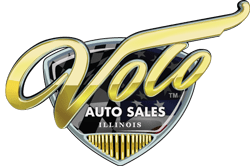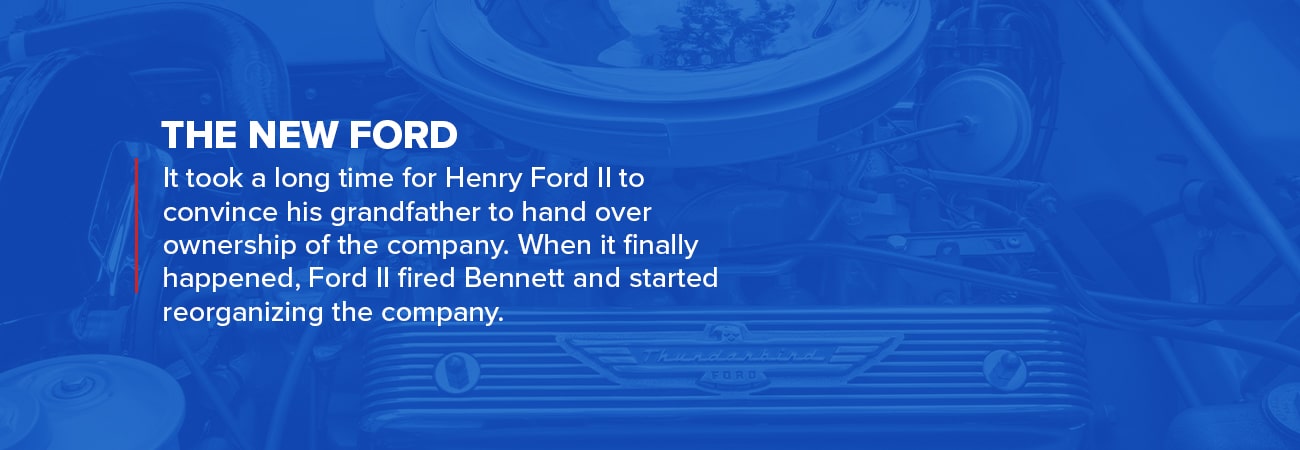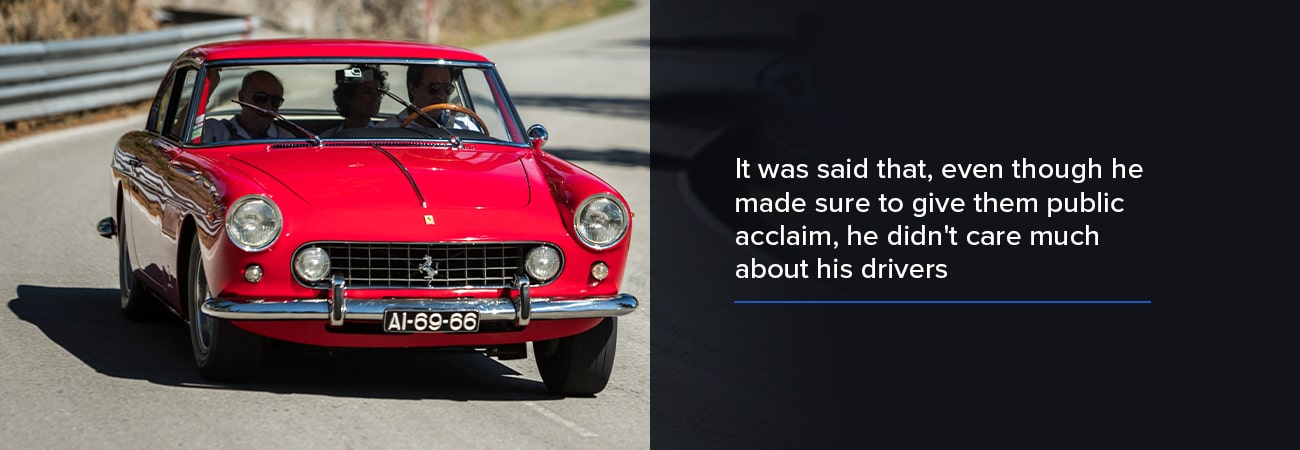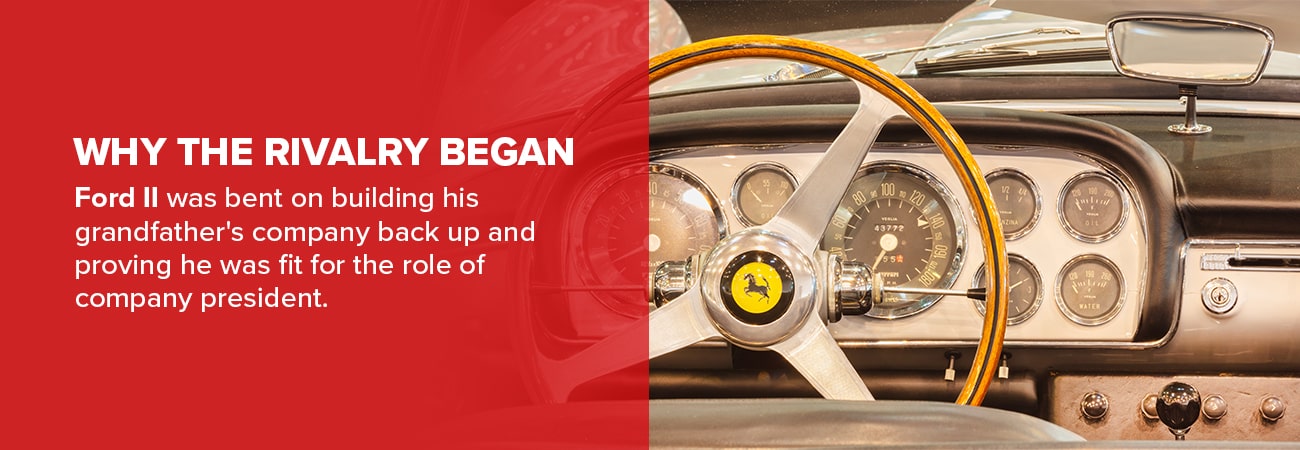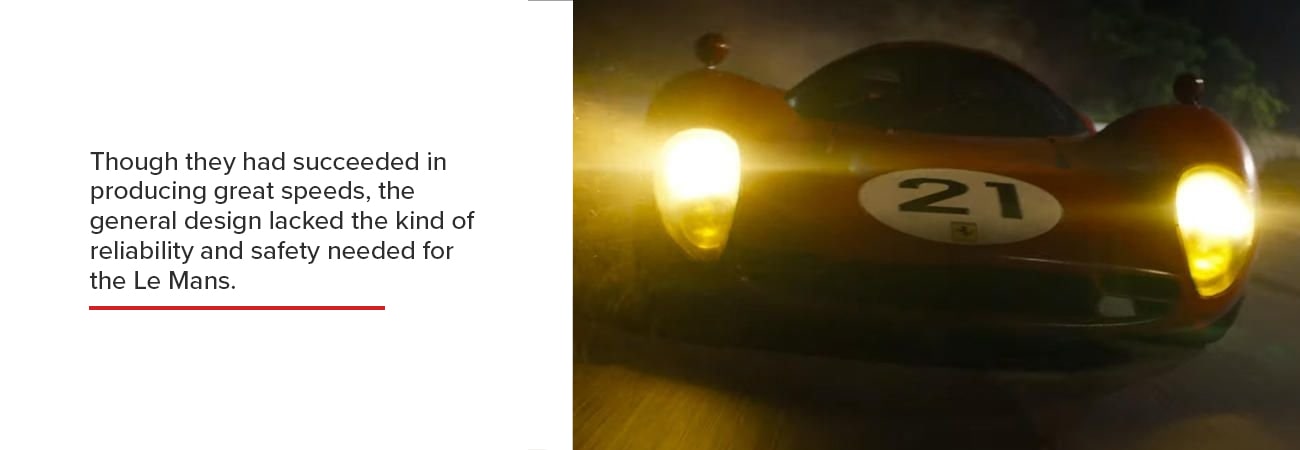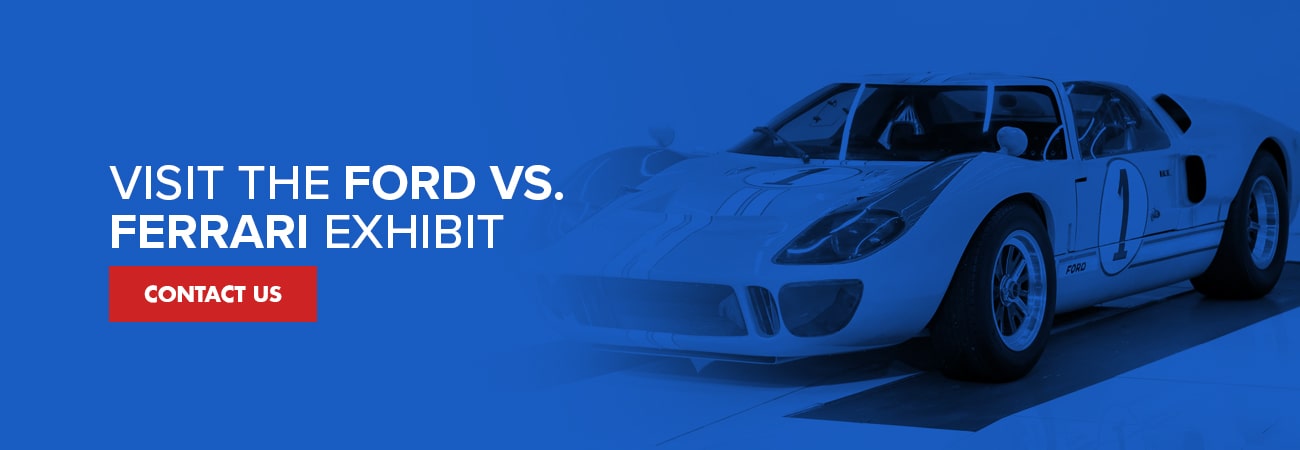
The Story Behind Ford Vs. Ferrari | Origins of Ford & Ferrari Rivalry

Few stories match the infamous Ford vs. Ferrari rivalry in the auto world. From the dramatic beginnings of a botched business deal to intense innovation and furious motivation, to great personalities and tragic endings — Ford vs. Ferrari is a story that seems written up for a Hollywood script — one of the primary reasons it was eventually adapted to the big screen.
Still, even that near three-hour film couldn't cover the grand story that was lurking behind Ford vs. Ferrari. In truth, there was a lot more to it — in the designing process for the Ford GT40, in the origins of giant companies and in the big personalities of Carroll Shelby and Ken Miles.
Here, we'll take a look at the Ford vs. Ferrari story in its full scope, digging deep into what really happened, how it happened and what it means for the auto industry today.
The Origins of Ford
The story started with the origins of two major car companies — Ford and Ferrari. Behind each company was an innovator, each ingenious in their own right. Though very different, each had a vision they brought to life.
The Ford Motor Company
Henry Ford's vision may have started in a workshop behind his home in Detroit in 1896, where he made his very first car. Seven years later, in 1903, Ford would go on to start the Ford Motor Company.
The Model T, introduced in 1908, essentially introduced the world to driving. The car soon became affordable to most of the public, and soon the streets were full of vehicles on wheels honking and turning down the streets.
Demand was so large for the Model T that Ford needed to develop innovative mass-production methods just to keep up. This led to assembly lines, enhanced wages and the eight-hour workday at Ford plants. It wasn't long before other Ford branches started opening up overseas, the first being in Manchester, England, in 1911.
Expansion continued steadily. During wartime, Ford helped manufacture cars, planes and tanks in the U.S. military. In 1919, Edsel Ford — Henry Ford's only child — took over as president of the Ford Motor Company. Edsel Ford served until 1943, when he passed away from cancer. Henry Ford took over for two years until his grandson, Henry Ford II, returned from war to take over as president of Ford Motor Company in 1945.
Decline
In the years leading up to Ford II's presidency, the company had started to evolve into disarray. Organization was lacking, bookkeeping was behind and general management had started to grow poor. Company profits had been stagnant for nearly the last decade, and the company had fallen into a deep third place in the “Big Three” of major car corporations — GM, Chrysler and Ford. The company was teetering on the edge of bankruptcy. It fell into the hands of the inexperienced Ford II to somehow return the Ford Motor Company to its former glory.
While there seemed to be declining morale at the company, there didn't seem too much excitement for the new president, either — Henry Ford II hadn't been able to graduate from Yale because he'd been caught paying someone to write a term paper for him. When he returned from war to take over the company, he had little to no experience of the inner workings of the company. For a while, according to Ford II, he “just moseyed around and tried to figure out what was going on.”
It turned out that even before Henry Ford II could take over the company, he first had to prove himself. As a young man in a giant, failing company, he frequently butted heads with Harry Bennett — the elder Ford's right-hand man who had gradually increased his power as Henry Ford grew older and weaker.
The New Ford
It took a long time for Henry Ford II to convince his grandfather to hand over ownership of the company. When it finally happened, Ford II fired Bennett and started reorganizing the company. Though he was hungry for change, the young Ford was also realistic — he recognized that he would need a lot of help to turn the Ford company around.
He sought to bring in new innovators and those with experience in other car companies like GM. One of his first hires was Ernest R. Breech, a former GM vice president. After some convincing, Breech finally took the job offer and came to clean up at Ford.
Breech recalled, “For a modern business, it was pitiful.” Equipment had become obsolete, workers had become incompetent and financial records were abysmal. Even with such obstacles, Breech was able to draw a profit and steadily increase revenue over the ensuing years.
Changes were made quickly and aggressively. Henry Ford II continued to hire fresh talent, hiring 10 up-and-coming innovators known as “Whiz Kids,” including Robert McNamara, who built a lasting culture and help the company flourish. Ford II used these new management pieces to replicate the structure of GM.
Triumph
From its heavy years under the power of an aging mogul and a power-hungry henchman, Ford finally started to regain admiration in the auto industry. A seller's market, paired with a complete overhaul of management, put the company back on the map.
Many still see Henry Ford II as the savior of the Ford Motor Company — a member of the family who was able to bring the brand out of dark times. This prosperity would last a long time. It would be years later, during a fateful business deal with Ferrari, when Henry Ford II would start to feel the earth shift under his feet once again.
The Origins of Ferrari
As one man — Henry Ford — was the mastermind behind the megalith company we know today, Enzo Ferrari was the genius behind the rival manufacturing giant. Growing up with little education in Italy, Enzo was lined up to have a relatively ordinary life. He came from a family of meager means, though there was something in him that drew him toward the outstanding. Enzo saw his first motor race in 1908, a moment that would have a profound effect on him.
Soon after, both his father and brother died in 1916. This tragedy may have been what propelled him to chase after what he loved — racing.
Alfa Romeo
Looking for any way to break into the racing industry, Enzo finally landed a job test-driving cars for a small automobile company in Milan after World War I. After honing his skills, Ferrari became a racecar driver for the Alfa Romeo Company in 1920. At the time, Alfa Romeo was a budding racing company that was becoming increasingly popular in the racing scene.
Ferrari proved to be a great racer and, for nearly a decade, helped Alfa Romeo on the tracks. He was becoming more and more interested in the organizational structure of racing, however, and he soon retired to form his own racing stable, Scuderia Ferrari. This is also around the time the famous prancing pony would grace the Ferrari's design.
The emblem had been used by Francesco Baracca, an Italian fighter pilot who had been in the same squadron as Enzo's late brother. Baracca's parents were said to have given Enzo a necklace with the prancing pony, though there's some disagreement about that event. If true, the logo seemed to have been a way to honor both Baracca and his family.
Obstacles to Success
The new Ferrari company soon hit a number of obstacles. The short-lived Scuderia Ferrari company was dissolved in 1937 as Alfa Romeo started to face fierce competition from other manufacturers.
Facing a disagreement with Alfa Romeo's boss and determined to continue building his own racing cars, Enzo left to start Auto Avio Costruzioni — a company that supplied parts to racing teams. When World War II started, Italy's fascist government under Mussolini forced Enzo's factory to start producing munitions. During the war, the factory was bombed by the Allies, forcing Enzo to move once again. In 1947, Ferrari S.p.A was inaugurated.
From there, Enzo began building one of the most notorious brands in the auto world. Known for their outrageous speed and quality construction, Ferrari's cars soon started dominating the track. In 1951, Enzo achieved his goal of beating Alfa Romeo in a race — a moment that cemented Ferrari as a racing juggernaut and symbolized the success of the underdog Enzo. Ferrari has since been a competitive staple in Formula 1 and Grand Prix races alike.
Expansion
Ferrari started out as a racing company — producing cars was simply a way to feed the central goal to win races. But the company soon became a major facet in the auto manufacturing world. Ferrari expanded overseas to the United States. Its flashy designs appealed to the Hollywood elite and stars like Steve McQueen and Clint Eastwood embraced the brand.
Still, Enzo Ferrari's goals always seemed to be targeted on one thing — winning the race. Some argued that his focus was on the cars more than the racers. It was said that, even though he made sure to give them public acclaim, he didn't care much about his drivers. During one dark time in Ferrari history in which many drivers died while racing, Enzo actually faced charges of manslaughter.
Enzo, born from modest means and family tragedy, was a man intent on making something of his life. Driven toward success and winning, he would stop at nothing to build his brand into a lasting, cherished company that would survive long past his death. This drive would be reminiscent of another man in another country with a different plan. When Henry Ford II and Enzo Ferrari first became involved in business talks, the result should have been easy to see.
Why the Rivalry Began
Ford II was bent on building his grandfather's company back up and proving he was fit for the role of company president. For years, he carved out his own path through the shadow of his grandfather, knocking out opponents like Bennet and convincing Ford Sr. to hand over control.
Enzo, on the other hand, had come from a long history of setbacks and tragedy. Hardened by life and motivated by his love for winning, he was ruthless in his business moves and relentless as a salesman.
Appealing to the Youth
In the 1960s, Ford was facing challenges once again. Coming off of failed experiments like the 1958 Edsel and failing to appeal to the wider crowd, Ford's sales were dimming in comparison to General Motors. The new generation of baby boomers now had disposable income and was looking for something else besides the generally boxy look of Ford vehicles.
Instead of reliability being the main selling point, these younger, deep-pocketed youths wanted something fast and sexy. Ford did not have that kind of reputation, so the company sought out a way to bring performance and flashy designs into the fold.
Top executives like Lee Iacocca helped Ford II craft a plan for what to do next. The answer was simple — they needed a sports car. The problem was that Ford didn't have anything in their portfolio yet resembling a sports car and no future plans to build one. So, instead of actually producing a sports car, Ford II would simply buy a company that made them. Wielding a company treasure chest full of millions of dollars as a negotiation tactic, Ford II went on the hunt for this acquisition.
The Ferrari Deal
The easy solution was to buy Ferrari — a racing juggernaut that was focused on winning first and producing cars second. As Ford put the plan together, it seemed perfect — Ford would acquire a flashy, struggling company that would attract that new generation who wanted something fast and edgy. Once negotiations started, Enzo himself seemed to like the deal, as well, as he was becoming tired of having to handle the day-to-day dealings of the company.
Negotiations continued for months. In the Spring of 1963, Ford and Ferrari seemed on the verge of closing the deal. The Ford offer came with a caveat — Enzo would have to give up control of the budget. In turn, this would mean Enzo would no longer have a complete say over the Ferrari racing team. This clause of the deal was too much for Enzo. Winning on the track was Enzo's legacy — the one thing he held dear to his heart and that he would never give up — not even for millions of dollars.
In the last moments, Ferrari pulled out of the deal. Ugliness ensued. Instead of merely retracting from the deal, Enzo seemed to be personally affronted by the offer.
Enzo Ferrari communicated to Ford II that he would never sell under those conditions. He called the company ugly, Ford's cars ugly and the factory in which they were built ugly. It is also rumored that Enzo then went after Henry Ford II personally, making comments about how his grandfather had been a much better man than he was and that the real Henry Ford was dead, leaving Ford II as a poor, unfit replacement.
Humiliation and Revenge
Ford was left emptyhanded, with months of time wasted and a plan in tatters. After the failed Edsel project and growth stagnant, the breakdown of the deal seemed like a pivotal moment that could put Ford on its back. It didn't end when Ferrari left negotiations, of course — Enzo turned around soon after and sold a majority stake of his company to Italian automaker Fiat.
Many at Ford now saw that the negotiations may never have been real at all. It all may have been a simple ploy to make Fiat raise their offer.
The betrayal of Enzo seemed to create a kind of perfect storm for Ford. Sales were lacking, multiple failures had happened publicly and now a major deal had fallen through that was supposed to revitalize the brand. And not only had the deal fallen through — it had happened on the global stage. Henry Ford II had been insulted, bamboozled and humiliated. Enzo had targeted one of Ford II's main insecurities — that he hadn't lived up to his grandfather's reputation.
The failed deal could have sent the Ford company into a dark time, rolling in its own failure and becoming the laughingstock of the auto world. But Ford II knew what it took to get out of a bad situation — he'd had to claw his way through obstacles when he first got to the company. Transforming his failure into anger and motivation, Henry Ford II set out to get revenge against Enzo Ferrari.
Ford would aim for the heart. Since Enzo prized winning more than anything else, they would focus on the track. Ford would try to build a vehicle that would not only compete with Ferrari but dominate it. Their target was Ferrari's prized and prestigious car race — the 24 Hours of Le Mans, a day-long race of speed and endurance in France.
How the Rivalry Went
Ford quickly set out to return Ferrari's favor and humiliate them on a global stage. Ford gave the task of building the “Ferrari Killer” to the Advanced Vehicles Group division in the United Kingdom. There, the origins of the legendary GT40 were born. Designers were using an engine that had been built by Ford's experimental group in Dearborn, Michigan.
The first GT40 models were fast but also very dangerous. Though they had succeeded in producing great speeds, the general design lacked the kind of reliability and safety needed for the Le Mans. It was calculated that when a driver hit the brakes on a GT40 on the track, they would heat up to a damaging temperature around 1,500 degrees Fahrenheit, effectively causing them to fail and rendering the car uncontrollable.
The 24 Hours of Le Mans was prized for a reason — with its blend of high speeds and endurance, it was a massive puzzle for racecar designers to solve.
Ford, being brand-new to the racing world, was struggling to build a vehicle that could compete in the harsh conditions of the Le Mans. The GT40 needed to be stable enough to run continuously for 24 hours and have the speed and handling to win. The first two races Ford entered to compete with Ferrari — the 1964 and 1965 Le Mans — were failures. Ford lost to Ferrari both times. Facing a third round of defeats, Ford needed a new angle for design.
They needed a race team with experience in racing and a keen eye for design. Ford put all of its chips behind the one of the only Americans to ever win at Le Mans — automotive designer Carroll Shelby.
The Rise of Carroll Shelby
Carroll Shelby was a legendary Los Angeles car designer who had already been a consultant on the GT40 project. Now, however, Ford was handing over the reins to Shelby and putting the entire rivalry on his shoulders. Win or lose, the pressure was now on Shelby to get it right.
Shelby was known for having a unique, outspoken personality, something that made him beloved by the general public. During his training missions as a youth at the San Antonio Aviation Cadet Center, Shelby would drop love notes onto his fiance's farm from the air.
Interestingly, Shelby didn't start out in a career in racing — when World War II ended, he started a dump truck business in Dallas, Texas. Four years later, he tried his luck raising chickens on a farm, but he soon went bankrupt when his second batch of chickens died from disease.
Around this time, Shelby finally started to pursue racing. In 1952, he drove a Ford V-8 hot rod in a quarter-mile drag race. From there, Shelby became increasingly involved in racing and started to cement himself as a racecar driver.
Shelby's racing skills were starting to become noticed. In 1954, after a co-drive in a DB3 at Sebring, Florida, Aston Martin offered Shelby a spot on the team at Le Mans in June.
Wild stories seemed to follow Shelby wherever he went — in November 1954, he T-boned a rock during a race in Mexico. His Austin-Healey flipped four times, shattering his elbows and leading to broken bones. He was found by Native Americans, who offered him alcohol to ease the pain while he waited for help.
In 1957, Sports Illustrated crowned him “Driver of the Year.” The same year, Shelby spun out on the very first lap of a race in a Maserati, ending up in the back of the pack. Somehow, he ended up passing everyone and winning the 100-mile race.
One of Shelby's most impressive highlights came in 1959 when he and Ray Salvadori co-drove an Aston Martin DBR1/300 at the 24 Hours of Le Mans to win.
In 1961, due to health issues, Carroll Shelby retired from racing to focus on building his own company. In 1962, he opened Shelby American in Venice, California, and soon after started producing the signature Cobra. At this point, Shelby had evolved from a racecar driver to something of an auto legend. Not only did he know how to win races as a driver, but he also knew how to construct vehicles that won and build teams that were successful.
If there was anyone that could compete with Ferrari in the 24 Hours Le Mans, Ford figured, it was the prestigious Shelby, who had started out raising chickens and was now one of the most well-known men in the racing world. Shelby himself had already developed a kind of rivalry with Ferrari himself, having been beaten by them in various races. He had his own motivation to fuel him toward the win at Le Mans.
Still, Carroll Shelby would need a trusted confidante and skilled racer to help propel the Ford team toward victory. He teamed up with driver Ken Miles to bring this dream to life.
Ken Miles
Although Carroll Shelby usually gets most of the attention in the auto world, those lesser-known actors like Ken Miles had a huge impact on racing and the rivalry in Ford vs. Ferrari.
Miles was born in England and picked up racing at a young age. He loved riding motorcycles — when he was 11 years old, he suffered a crash that broke his nose and knocked out three of his teeth. Throughout his life, Miles would describe racing as a hobby, while his true passion lay in mechanics and actually designing and constructing vehicles. He was only 15 when he built his first car.
He was able to get a job as an apprentice at Wolseley Motors, where he was able to hone his skills as an auto craftsman. The war would soon force him out, however, and he would serve in the British Territorial Army as a staff sergeant in World War II. Miles even was a part of the D-Day landings at Normandy, operating in a tank unit.
When the war ended, Miles got a job as an engineer at Morris Motors in the United States. Miles was a unique racer in that he designed and constructed his own vehicles that he raced — and usually won in. He built up a wildly successful reputation with the Sports Car Club of America (SCCA).
Though known to be outspoken and sometimes disagreeable, Miles' thick English accent and general demeanor made him likable amongst most. Ken Miles was also known as being a gentleman on the track — maybe because he knew the cars he raced did well, he had a knack for avoiding other drivers on the track and driving cleanly.
With his success on display, Miles soon drew the attention of newly retired Carroll Shelby. It wasn't long before Shelby realized how prolific of a driver Miles was and he soon became the chief test driver of Shelby American. The relationship between Shelby and Miles was one of the most fruitful in the auto industry. It was two big personalities teaming up to create some of the fastest and best vehicles ever created.
When Ford came to Shelby asking for help to beat Ferrari, he and Miles set to work to create a car that would dominate the field.
Transforming the GT40
Carroll Shelby and Ken Miles started reinventing the GT40. One of the first things they sought to do was improve the handling and stability of the vehicle. To do this, they needed to drastically upgrade its aerodynamics. One of the ways they did this was through flow testing. Miles and Shelby taped wool streamers to the vehicle's exterior to see how air traveled around the car. If the streamers didn't lie flat, then it meant there were factors hurting the GT40's aerodynamics.
Phil Remington, a Ford engineer, introduced a quick-change brake system that allowed mechanics to quickly swap out fresh pads and rotors during the race. This offered an effective solution to the problem of trying to get brakes to last the entire race.
The team also used a dynamometer to help with reliability during the race. A dynamometer measures speed, power and force, a common feature of cars today that was revolutionary back then. They used this device during practice sessions before Le Mans to recreate stress points on the track. Using this, they could then replicate those conditions and make sure their vehicles had the stamina to carry through the entire race.
When the 1966 24 Hour of Le Mans arrived, it was time for Shelby and Miles to see if all their hard work had paid off.
Success at Le Mans
The GT40 MK II blew away the competition at the 1966 Le Mans and buried Ferrari. Ferrari didn't even have any cars that finished the race, while Ford's cars finished first, second and third. Ken Miles had pulled away from the pack and was ready to take first place by a landslide. Since he'd won at Sebring and Daytona earlier that year, with this win Miles would have the Triple Crown — the first driver ever to accomplish the feat.
But as the race neared its end, the Ford public relations crew wanted a final picture to display their dominance over the field. Miles was ordered to slow down to second and third place so they could get a photo-finish of all three GT40s together at the end.
Being the loyal employee that he was, Miles agreed and slowed to the others. The media team got the photo finish at the end, but Ken Miles was denied the win — since the second-place driver Bruce McLaren started farther behind than Miles, he was awarded the win, even though Miles had ultimately been faster.
It was an unfortunate mistake of the rules that robbed Ken Miles of his Triple Crown. Still, he took the loss in stride and congratulated Bruce McLaren on his victory while also downplaying the moment to the press, thanking Ford for letting him drive and being a part of the team. Sadly, later that same year, Miles would die in a crash test driving one of his cars. Until recently, and thanks to the help of Hollywood movie Ford. vs. Ferrari bringing him to life, Ken Miles had been a footnote in the auto world.
The Legacy of the Ford GT40
When Ford took the crown at Le Mans, it symbolized more than just winning a race. Just three years earlier, Ford had been a stranger to the performance genre. Now, with the help of Carroll Shelby, Ken Miles and many other bright and innovative minds, the GT40 had dominated one of the most prestigious races in the world.
Henry Ford II was able to achieve something that the world could marvel at. The legendary Mustang would soon hit production, blasting Ford into the sports car industry. The GT40 lives on as the “Ferrari Killer” — a cherished vehicle that is revered by auto fans everywhere.
The Movies
The Ford vs. Ferrari story was brought to life by the 2019 film starring Matt Damon and Christian Bale, “Ford v Ferrari.” As with most movies, it's based on real-life events with some ad-ins or dramatizations to make it more exciting for the audience. The movie helped bring a relatively unknown story into the mainstream, highlighting those hidden figures like Ken Miles who deserve a lot of recognition for uplifting an entire brand.
Ford vs. Ferrari FAQs
Here are some frequently asked questions about the Ford vs. Ferrari saga.
What Is the True Story Behind “Ford v Ferrari”?
In 1963, Ford was in negotiations with Ferrari to acquire the company. Right as they were about to close the deal, Enzo Ferrari backed out because he didn't want to relinquish control over his racing team. Enzo then insulted the company and turned around and sold major stock of Ferrari to Fiat. Ford sought revenge on the racetrack at the 24 Hour of Le Mans.
Does Fiat Own Ferrari?
Fiat does not own Ferrari, despite having 90% ownership of the company in 1988. After Enzo Ferrari sold 50% of his company to Fiat in 1969, Fiat continued to expand its ownership of the brand, leaving Enzo Ferrari with just a 10% stake left. However, in 2014, Fiat Chrysler Automobiles announced that it would be parting ways with Ferrari. Eventually, Ferrari was listed on the New York Stock Exchange, making the investing public the primary owner of Ferrari while Piero Ferrari, the son of Enzo Ferrari, still owns 10% of the company that was held by his father.
What Is the Message in “Ford v Ferrari”?
A lot of Ford vs. Ferrari revolves around redemption and innovation — when Ford was betrayed by Ferrari, they sought to redeem themselves by building a car that was greater than anything they had yet created. In this way, a central message of “Ford v Ferrari” is that one can achieve success not through putting down others but by building up oneself through trial and error.
Is the Ken Miles Story True?
Ken Miles was on his way to winning the 24 Hours of Le Mans when Ford told him to slow down to get a photo-finish with second and third place. Because the second-place driver started the race farther back than he, Miles lost the race.
What Did Carroll Shelby Say About Ken Miles?
After his death, Carroll Shelby talked about what kind of man Ken Miles was. He called Ken a world-class driver, a great help to others on the racing team and “the heart and soul of our testing program.”
View Other Ford Vehicle Guides:
Visit the Ford vs. Ferrari Exhibit
At Volo Museum Auto Sales, you can come see the cars from "Ford v Ferrari." We even offer the 1966 GT40s from the film for rent! Come stop by Volo Museum Auto Sales to check out these cars and many more from your favorite movies.
